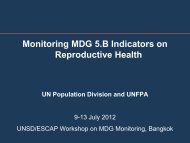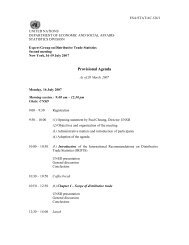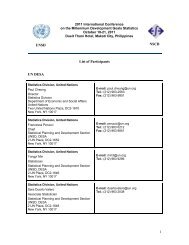demographic yearbook annuaire demographique 1951
demographic yearbook annuaire demographique 1951
demographic yearbook annuaire demographique 1951
You also want an ePaper? Increase the reach of your titles
YUMPU automatically turns print PDFs into web optimized ePapers that Google loves.
population bases for different dates within the year (e.g., the<br />
midyear population in the crude rate table and the population<br />
at the census date in the age-specific rate table) are<br />
not noted. These differences are very small, seldom amounting<br />
to more than one unit in the decimal place.<br />
Table 72 presents a summary of crude death rates for<br />
64 areas, during the period 1905 to 1930. This is a companion<br />
table to the one presenting crude birth rates for the<br />
same period (table 5). These rates are averages for the<br />
periods 1905-1909, 1911-1913, 1921-1925 and 1926-1930<br />
and were taken from the League of Nations Yearbook.<br />
1 able 73 gives the total number of deaths for each year,<br />
1935 to 1950, as reported for 143 areas. The geographic<br />
coverage represented by these data is somewh_at less than<br />
that implied by the number of areas. In a number of cases<br />
the statistics are confined to the non-indigenous segments<br />
of the population. As a consequence, the data for some<br />
regions, and particularly for the continent of Africa, are of<br />
only minor significance.<br />
Table 74 presents annual crude death rates for the period<br />
1930 to 1950 for 131 areas. Despite the many limitations<br />
already described, which affect the accuracy, comparability<br />
and geographic coverage of these data (not to mention the<br />
limitations that always apply with respect to crude rates),<br />
they nevertheless present the most comprehensive survey<br />
of general levels and trends that is so far available.<br />
The crude rate is the number of deaths reported for a<br />
calendar year per 1,000 persons present in the same geographic<br />
area at the mid-point of the year. Wherever possible,<br />
rates which do not represent complete coverage either<br />
of geographic areas or of segments of population, or in which<br />
there is some lack of correspondence between the two components,<br />
are so noted. Rates are not shown where the coverage<br />
of the death statistics differs importantly from that of<br />
the available population base.<br />
Table 75 presents statistics of deaths for recent years, classified<br />
by month of death. Data are shown for 83 areas and<br />
cover periods ranging from 1 to 4 years. In so far as possible,<br />
the distribution is by month of occurrence rather than by<br />
month of registration, but in a number ofcases monthly data<br />
were available only on a date-of-registration basis. Figures<br />
indicated as provisional generally refer to the month of<br />
registration and are likely to differ slightly from annual<br />
totals shown in other tables. The usefulness of the data for<br />
the purpose of seasonal analysis is therefore somewhat restricted.<br />
However, most of the countries for which statistics<br />
are shown have efficient registration systems and the monthto-month<br />
fluctuations in the number of deaths registered<br />
may be expected to reflect rather closely the month-tomonth<br />
fluctuations in the number of deaths that occurred.<br />
Table 76 and table 77 present statistics of deaths classified<br />
by age and sex for the period 1936 to 1950. The annual<br />
numbers are given in table 16 for 91 areas. Figures are shown<br />
for each sex, but, for reasons of space, not for the two sexes<br />
combined. Deaths of unstated sex are therefore excluded<br />
and the implied totals occasionally differ from those shown<br />
in table 13. The numbers so excluded are given in footnotes<br />
except where the exclusion was regarded as without significance<br />
and, even then, the exclusion is noted unless the<br />
number involved was less than 10.<br />
The age classification is in the main based on the dates<br />
of birth and death and is expressed in completed years.<br />
Some countries, however, base the age classification on the<br />
year of birth, the age at death being determined by subtracting<br />
the year of birth from the year of death. The only<br />
country known to follow this procedure is Norway. For that<br />
country statistics of infant deaths are shown by year of birth<br />
in table 16, but are adjusted to date of birth in the infant<br />
mortality tables.<br />
Death rates specific for age and sex are presented in table<br />
17 for 54 areas. The accuracy of these data is subject to the<br />
same kinds of reservations regarding deficiencies in statistics<br />
by age as those discussed heretofore. The number of countries<br />
and years for which data are shown is considerably<br />
smaller than in the preceding table, statistics of the population<br />
by age being less frequently available than statistics<br />
of deaths by age.<br />
In computing the rates, deaths at unknown ages and the<br />
population of unknown age were disregarded except as they<br />
formed part of the death rates for all ages combined. Each<br />
rate is, therefore, the number of deaths at a given age that<br />
occurred during the course of a year per 1,000 persons of<br />
that age at the middle of the year or at another date within<br />
the year. It should be noted that the rates for persons under<br />
1 year of age in this table differ from the infant mortality<br />
rates shown in table 19, the latter being based on live births<br />
for the year rather than on the population under 1 at the<br />
middle ofthe year. Also, the rates for all ages combined differ<br />
in a number of cases from those shown in table 14, the reason<br />
being that they are based on the total population at the<br />
same date as that for which an age distribution was available<br />
for the computation of age-specific rates (usually a<br />
census date). In a few instances the difference is attributable<br />
to the fact that the rates in this table were based on the<br />
mean population (obtained by averaging age data for two<br />
successive Decembers), whereas the corresponding rate in<br />
table 14 is based on an estimate for 1 July. Differences of<br />
these types are very small and are not noted in the table.<br />
The problem of obtaining precise correspondence between<br />
the deaths of the population in the inclusion or<br />
exclusion of armed forces, refugees, displaced persons and<br />
other special groups is particularly difficult where agespecific<br />
rates are concerned. In cases where it was not<br />
possible to achieve such a correspondence, the differences<br />
in coverage are noted. Male rates in the age range 20 to 40<br />
years, particularly during the war period, are affected by<br />
this non-correspondence and care should be exercised in<br />
using these rates for comparative purposes. It should be<br />
added that even when deaths and population do correspond<br />
the comparability of the rates may be affected by abnormal<br />
conditions such as absence from the area of large numbers<br />
of young men in the military forces. The result is that death<br />
rates appear high in these ages, simply because a large section<br />
of the able-bodied members of the age group, whose<br />
death rates under normal conditions would be less than the<br />
average for persons of their age, have been removed from<br />
the computations.<br />
Because of the general confusion surrounding this problem,<br />
the disposition of armed forces, as regards both the<br />
population base and the deaths, is noted in all cases where<br />
the disposition could be ascertained and where there might<br />
be some question as to the exact coverage of the two components<br />
of the rates.<br />
Tables 78 to 27 present statistics of infant mortality (deaths<br />
of infants less than 1 year of age). The completeness and<br />
accuracy of these statistics are highly variable. There is some<br />
evidence that the underregistration of deaths is proportionately<br />
greater for infants than for other ages.<br />
Table 78 gives the total number of infant deaths for 120<br />
areas for the period 1935 to 1950, and table 79 gives infant<br />
34













